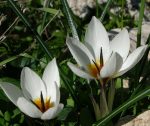 Native to rocky areas and undergrowth of Israel, Lebanon, Palestine, and Syria, this perennial corm is a member of the iris family, Iridaceae, that also includes gladiolus, crocosmia, and blue-eyed grass. The plant grows 1-3″ tall and has a rosette of grass-like leaves with a central white line along the leaf axis. The solitary cup-shaped flowers appear from November to February and have a white perianth of 6 parts that are fused and feature a yellow blotch in the center with 3 conspicuous purple-black stamens. Winter crocus has the distinction of appearing in winter when little else blooms and is a good choice for rock or gravel gardens. The genus name, Crocus, is from the Greek word κρόκος, krokos meaning thread and refers to the appearance of the stigmas. The specific epithet, hyemalis, is the Latin word meaning wintery, and refers to the time of flowering.
Native to rocky areas and undergrowth of Israel, Lebanon, Palestine, and Syria, this perennial corm is a member of the iris family, Iridaceae, that also includes gladiolus, crocosmia, and blue-eyed grass. The plant grows 1-3″ tall and has a rosette of grass-like leaves with a central white line along the leaf axis. The solitary cup-shaped flowers appear from November to February and have a white perianth of 6 parts that are fused and feature a yellow blotch in the center with 3 conspicuous purple-black stamens. Winter crocus has the distinction of appearing in winter when little else blooms and is a good choice for rock or gravel gardens. The genus name, Crocus, is from the Greek word κρόκος, krokos meaning thread and refers to the appearance of the stigmas. The specific epithet, hyemalis, is the Latin word meaning wintery, and refers to the time of flowering.
Type: Perennial corm
Bloom: White perianth with yellow blotch in the center from November to February
Size: 1-3″ H
Light: Full sun
Soil: Average, medium moist, gritty sandy, well-drained
Hardiness: Zones 8-10 (unverified)
Care: Low maintenance
Pests and Diseases: Unavailable
Propagation: Offsets
Companion Plants: Pansies, stock, sweet alyssum
Outstanding Selections: None
Photo Credit: Wikipedia